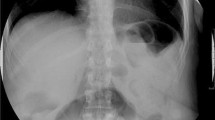Abstract
Background: The authors investigated whether there is any correlation between gastric pouch size measured by routine upper gastrointestinal contrast study (UGI) after laparoscopic Roux-en-Y gastric bypass (LRYGBP) and short-term weight loss.
Methods: The study group consisted of 82 patients (66F, 16M) who underwent LRYGBP. Body mass index before surgery ranged from 35.4 to 71.7 kg/m2, with a mean of 47.4 kg/m2. UGI was performed 1 day after LRYGBP in all patients. Proximal gastric pouch size was estimated by multiplying maximal transverse and longitudinal diameters on AP spot image or film. Percent excess weight loss (%EWL) obtained at 3, 6, 12 and 24 months after surgery was used as an indicator of short-term results. According to the presence of contrast passage through the gastrojejunostomy, each patient was classified into 2 groups: Group A, negative; Group B, positive.
Results: There was no correlation between proximal gastric pouch size and %EWL at any point of time (P>0.05). The correlation coefficients calculated for 3, 6, 12 and 24 months after surgery were 0.038, 0.110, 0.015 and 0.042, respectively (Pearson correlation test). The gastric pouch size of Group A was larger than that of Group B (Studentt-test,P<0.001). There was no difference in %EWL between Groups A and B at 3 and 6 months after surgery (P>0.05).
Conclusion: Pouch size area, measured by routine UGI study on the first postoperative day, does not influence short-term postoperative weight loss.
Similar content being viewed by others
References
Stoeckli R, Chanda R, Langer I et al. Changes of body weight and plasma ghrelin levels after gastric banding and gastric bypass. Obes Res 2004; 12: 346–50.
Freedman MR, King J, Kennedy E. Popular diets: a scientific review Obes Res 2001; 9 (Suppl 1):1S-40S.
Schauer PR, Ikramuddin S. Laparoscopic surgery for morbid obesity. Surg Clin North Am 2001; 81: 1145–79.
Wittgrove AC, Clark GW. Laparoscopic gastric bypass, Roux-en-Y — 500 patients: Technique and results, with 3–60 month follow-up. Obes Surg 2000; 10: 233–9.
Stoopen-Margain E, Fajardo R, Espana N et al. Laparoscopic Roux-en-Y gastric bypass for morbid obesity: results of our learning curve in 100 consecutive patients. Obes Surg 2004; 14: 201–5.
Higa KD, Boone KB, Ho T et al. Laparoscopic Roux-en-Y gastric bypass for morbid obesity. Technique and preliminary results of our first 400 patients. Arch Surg 2000; 135: 1029–34.
Serafini F, Anderson W, Ghassemi P et al. The utility of contrast studies and drains in the management of patients after Roux-en-Y gastic bypass. Obes Surg 2002; 12: 34–8.
Blachar A, Federle MP, Pearler KM et al. Gastrointestinal complications of laparoscopic Roux-en-Y gastric bypass surgery: clinical and imaging findings. Radiology 2002; 223: 625–32.
Sims TL, Mullican MA, Hamilton EC et al. Routine upper gastrointestinal Gastrografin swallow after laparoscopic Roux-en-Y gastric bypass. Obes Res 2003; 13: 66–72.
Carucci LR, Turner MA. Radiologic evaluation following Roux-en-Y gastric bypass surgery for morbid obesity. Eur J Radiol 2005; 53: 353–65.
Gastrointestinal surgery for severe obesity. National Institutes of Health Consensus Development Conference Draft Statement. Obes Surg 1991; 1: 257–65.
Madan AK, Tichansky DS, Phillips JC. Does pouch size matter? Obes Surg 2007; 17: 317–20.
Raftopoulos I, Ercole F, Udekwu AO et al. Outcomes of Roux-en-Y gastric bypass stratified by a body mass index of 70 kg/m2: a comparative analysis of 825 procedures. J Gastrointest Surg 2005; 9: 44–53.
Flanagan L. Measurement of functional pouch volume following the gastric bypass procedure. Obes Surg 1996; 6: 38–43.
Author information
Authors and Affiliations
Corresponding author
Rights and permissions
About this article
Cite this article
Nishie, A., Brown, B., Barloon, T. et al. Comparison of size of proximal gastric pouch and short-term weight loss following routine upper gastrointestinal contrast study after laparoscopic Roux-en-Y gastric bypass. OBES SURG 17, 1183–1188 (2007). https://doi.org/10.1007/s11695-007-9200-5
Received:
Accepted:
Issue Date:
DOI: https://doi.org/10.1007/s11695-007-9200-5




